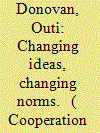| Srl | Item |
| 1 |
ID:
160812


|
|
|
|
|
| Summary/Abstract |
Whilst much has been written on emergence of new norms in international politics, we know significantly less about changes to the ideas and assumptions that underpin such norms. Examined at micro-level, most norms consist of a set of ideas and assumptions that form the basis of what is considered as appropriate, legitimate or even the required thing to do. Far from being stable, ideational constitutions of norms can undergo significant changes in the course of the norm emergence process. Enquiring into such changes is important if we are to move beyond static and linear accounts of norm evolution. Using changes in the ideational constitution of the responsibility to protect – specifically, the de-emphasis of the responsibility to rebuild – as its vantage point, the analysis seeks to answer the following question: what drives change in ideational constitutions of international norms? The chief argument advanced in this article is that misalignments at the level of broader normative structures (external misalignments) and within norms (internal misalignments) result in changes in the ideational constitutions of emerging norms.
|
|
|
|
|
|
|
|
|
|
|
|
|
|
|
|
| 2 |
ID:
150580


|
|
|
|
|
| Summary/Abstract |
While significant obstacles to the realization of the Responsibility to Protect in practice remain, it has nonetheless made considerable progress in transforming from an idea to an emerging norm. At the same time, however, its sister component, the Responsibility to Rebuild has elicited less scholarly and policy attention. The lack of attention to rebuilding responsibilities has been made all the more urgent by the violent aftermath of the first protection intervention in Libya in 2011. Against this backdrop, the article examines the way in which the Responsibility to Rebuild is understood and operationalized, with reference to Libya and Côte d'Ivoire, theaters of two recent protection interventions. The conceptual evolution of the Responsibility to Rebuild reveals a distinct shift toward a more statist understanding of the rebuilding phase; what was initially considered a part of the wider international protection responsibility has come to be viewed as a domestic responsibility. This recalibration of the responsibility to rebuild stems from the concept's association with the reactive element of R2P as well as from the changes in the wider normative environment. The more statist understanding of rebuilding responsibilities has manifested itself not only in the emphasis on domestic ownership of the rebuilding process in the wake of protection interventions, but also in the reconceptualization of the wider international Responsibility to Rebuild as a narrower responsibility to assist in building the capacity of the state subjected to protection intervention. This has been problematic in policy terms as the attempt to build capacity through the standard state-building measures has resulted at best in negative peace and at worst in armed violence.
|
|
|
|
|
|
|
|
|
|
|
|
|
|
|
|